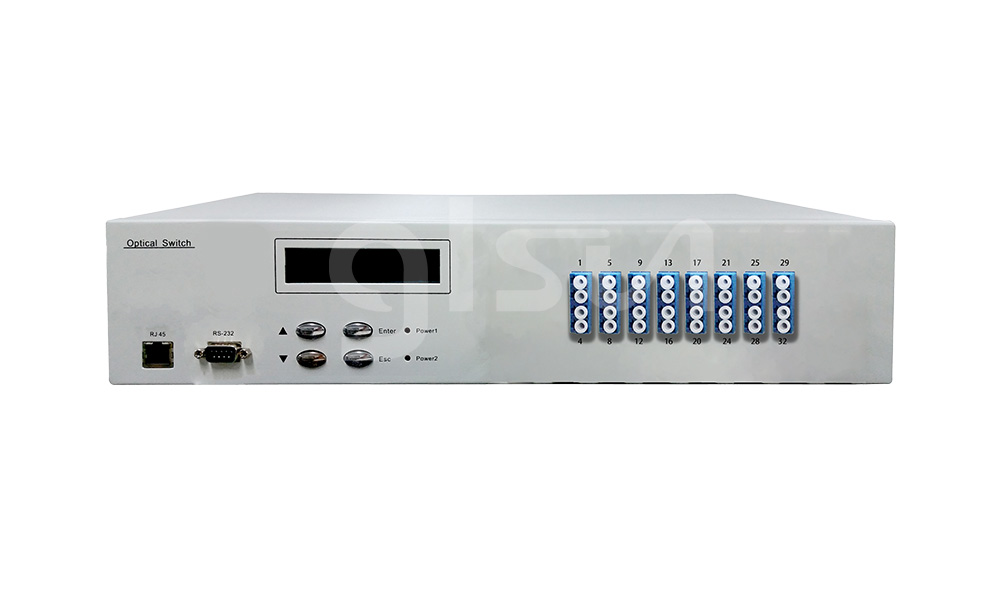How do MEMS Matrix Optical Switches Work in OCS?
2024-12-07
MEMS matrix optical switches are advanced devices that use micro-electromechanical systems to control the path of optical signals within a network. Unlike traditional mechanical or electronic switches, MEMS optical switches operate at the microscopic scale, enabling high-speed and precise light path control without converting optical signals into electrical signals. This non-intrusive switching minimizes latency, maintains signal integrity, and reduces power consumption, making MEMS switches a preferred choice for modern optical communication systems.

The matrix in MEMS optical switches refers to the two-dimensional array of micro-mirrors, which are key to their operation. These mirrors can tilt or move to direct light beams from an input port to a designated output port, facilitating dynamic and flexible optical signal routing.

In Optical Circuit Switching (OCS) networks, MEMS matrix optical switches serve as dynamic enablers for high-speed, efficient, and reliable optical signal routing. Their role extends beyond mere signal switching; they are integral to the seamless operation and adaptability of the network.
1. Traffic Management and Signal Routing
In OCS networks, optical signals travel through interconnected nodes that need to dynamically direct traffic to meet changing demands. MEMS matrix optical switches are central to this process. Their micro-mirrors act as flexible, programmable pathways for routing light signals between different fibers or network segments without requiring electrical conversion. This ability ensures low-latency data transmission and minimizes bottlenecks, even under high traffic loads.
2. Dynamic Path Configuration
OCS networks often experience fluctuating traffic patterns. MEMS matrix switches address this by dynamically reconfiguring optical paths in real-time. For instance, during peak periods, the switch can allocate additional bandwidth to high-demand routes, while during maintenance or outages, it can redirect signals to alternative paths to maintain service continuity.
3. Signal Integrity Maintenance
Optical signal integrity is critical in OCS networks, where data loss or degradation can disrupt communication. MEMS matrix optical switches excel in this area by offering low insertion loss and minimal crosstalk. Their precise alignment capabilities ensure that optical signals maintain their quality as they traverse the network.
4. Network Protection and Restoration
MEMS switches play a vital role in protecting OCS networks against failures. In the event of a fiber cut or equipment failure, the switch can rapidly reroute optical signals to backup paths, minimizing downtime. This fast recovery capability is essential for mission-critical applications such as financial transactions or healthcare communications.
5. Scalability and High-Port Density
As OCS networks grow to accommodate more users and devices, the scalability of MEMS matrix optical switches becomes an asset. Their compact design and ability to handle a high number of input and output ports make them ideal for dense network environments, such as data centers or metropolitan area networks.
6. Enabling Automation in OCS
MEMS matrix switches are often integrated with advanced software and control systems that enable automated network management. For example, they can work with software-defined networking (SDN) protocols to optimize light path configurations, balance loads, and adapt to changing network conditions without human intervention.
OCS networks rely on optical switches to manage traffic, reroute signals, and ensure reliable communication. MEMS matrix optical switches offer several advantages that make them indispensable in these systems:
1. Scalability
MEMS matrix switches can handle a large number of input and output ports, supporting the increasing demands of high-capacity networks.
2. Low Insertion Loss and Crosstalk
These switches provide excellent optical performance, with minimal loss of signal power and negligible interference between channels.
3. High Reliability
The solid-state nature of MEMS devices ensures long operational lifespans with minimal mechanical wear and tear.
4. Fast Switching Speed
MEMS switches are capable of switching light paths within milliseconds, which is critical for real-time applications.
5. Compact Size and Power Efficiency
Their microscopic components allow for compact designs, reducing the overall footprint of the switch while consuming less power compared to traditional alternatives.
MEMS matrix optical switches are a cornerstone of modern OCS networks, offering unmatched precision, scalability, and reliability. Their ability to dynamically manage optical signals without compromising signal integrity positions them as a key technology for the future of optical communication. As network demands grow, the role of MEMS switches will only become more critical, driving innovation and efficiency in the telecommunications industry.








